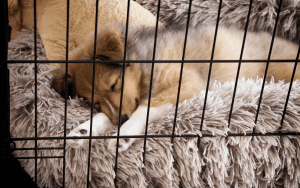
How to Crate Train Your Dog With a KONG
Training made easy, all thanks to KONG.
If you are a pet parent and you have a dog, you probably have a KONG somewhere in your home. As many of you probably know, a KONG isn’t just a toy, but can be used to solve many different things such as boredom, separation anxiety, and chewing, just to name a few. Today we are going to talk about how KONGs can be used as a tool to help crate train your dog.
But first, let’s talk a little about crate training and why we do it. One reason we crate train our furry friends is to help keep them safe when we aren’t around. Dogs tend to get bored when no one is with them and can potentially start chewing on things in your home, becoming destructive, which can be very dangerous. Having your dog safely in their crate will prevent this from happening. It is also very important to have a “safe place” for your dog where he is comfortable and can relax. The crate can provide this space and that sense of needed security.
When we are crate training our dogs, our goal is to create a positive association with the dog and the crate. We can do this by using a stuffed KONG. At this point it is very important that your dog has the correct KONG and that it is safe to leave with them. If you are unsure how to pick the correct KONG, you can visit our website here. When we start crate training, we want your pup to already understand what a KONG is and how to get food out of it. For more information, check out our “How to Stuff A KONG Guide” or you can also watch a short video on KONG 101. You can also work KONG into your daily routine and use it for your dog’s meals. Before you start crate training, you want to make sure that the crate is the proper size for your dog. The employees at your local pet store can help you pick out the right one for your dog. Once we have those things down, we are ready to start crate training.
When you start crate training, have the KONG ready to go and stuffed with something super yummy that your dog loves to eat. Lure your dog into the crate using the KONG. Have him lay down and give him the stuffed KONG. The key here is to leave the crate door open. If the dog comes out of the crate, as long as it is safe to do so, take the KONG away. Lure him back into the crate and repeat, again, leaving the door open. He will eventually learn that when he is in his crate, he gets his yummy, stuffed KONG. You can also feed him his meals in the crate with the door open, so he gets used to going in and out.
Once he is laying comfortably in his crate, eating the food in his KONG, with the door open, then you can start working on closing the door. When you start closing the door, you want to do it for short increments, so you don’t stress the dog. Once again, have that KONG stuffed and ready to go. Lure the dog into the crate and give him his KONG. As he is eating the food, close the door for 15-20 seconds, open the door back up and then praise your dog. If he is still comfortable and enjoying his KONG, do this again, this time leaving the door closed a little longer. Gradually increase how long the door stays closed. Keep repeating this process until you can leave the door closed for several minutes at a time. If at any point the dog seems to get frustrated or a little stressed, take a few steps back and start again at the point where he was comfortable.
This method should work for any age, size, or breed of dog. Keep in mind, depending on your dog, it may take several tries over several days to get your dog comfortable being in the crate for any length of time. The key is to make sure your dog loves her KONG before you start the crate training process. Then, keep trying and be consistent. But remember to work on your dog’s terms so he or she doesn’t get frustrated. Never force them in their crate. If training is done correctly, your dogs will enjoy being in their crate and will probably, eventually, start to go in on their own.
 from KONG Company
from KONG Company



